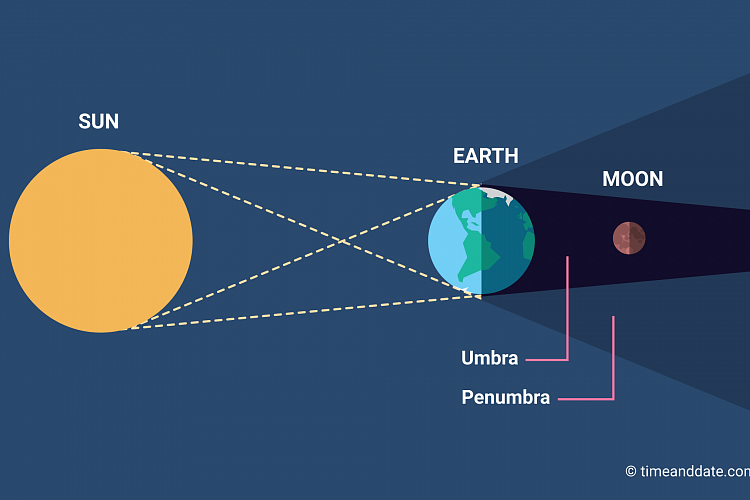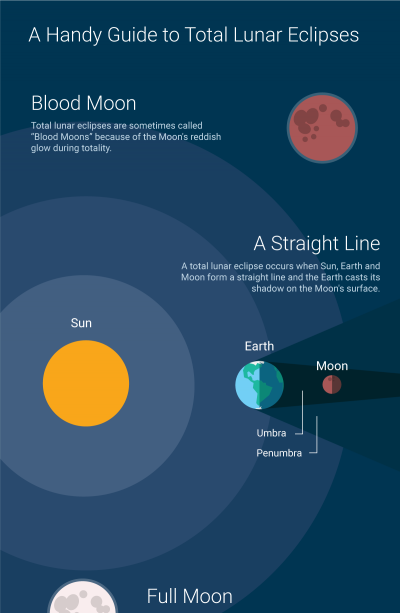A Total Lunar Eclipse or Blood Moon
A Total Lunar Eclipse can get a deep red glow and is sometimes called a Blood Moon . Earth casting its shadow on the Moon. timeandd...
http://globalexpressnews.blogspot.com/2015/09/a-total-lunar-eclipse-or-blood-moon.html
A Total Lunar Eclipse can get a deep red glow and is sometimes called a Blood Moon.

Taking pictures? Share them with us!
The Moon does not have its own light, but shines because its surface reflects the Sun's rays.
Eclipses of the Moon happen when the Sun, Earth and Moon are aligned to form an almost or exact straight line. The technical term for this is syzygy, which comes from the Greek word for being paired together.
Why do Total Lunar Eclipses happen?
During a Total Lunar Eclipse, the Sun, Earth and Moon form a straight line. The Earth blocks any direct sunlight from reaching the Moon. The Sun is behind the Earth, so the Sun's light casts the Earth's shadow on the Moon. This shadow covers the entire Moon and causes a Total Lunar Eclipse.Upcoming 5 Total Lunar Eclipses
| Dates | Path of the eclipse |
|---|---|
| 27 Sep / 28 Sep 2015 |  |
| 31 Jan 2018 |  |
| 27 Jul / 28 Jul 2018 |  |
| 20 Jan / 21 Jan 2019 |  |
| 26 May 2021 |  |
Earth's Three Shadows
The Earth's shadow can be divided into three parts:- Penumbra - the outer part.
- Umbra - darker, central part.
- Antumbra - a partly shaded area beyond the umbra.
Sun, Earth and Moon Aligned
For a lunar eclipse to occur, the Sun, Earth and Moon must be roughly aligned in a straight line. If the Sun, Earth and Moon do not align, the Earth cannot cast a shadow on the Moon's surface and an eclipse cannot happen.When the Sun, Earth and Moon are not perfectly aligned, only the outer part of the Earth's shadow covers the Moon. Such an eclipse is called a penumbral lunar eclipse. In a Total Lunar Eclipse, the Earth's umbra completely covers the Moon.
The Earth's umbra is about 870,000 miles (1.4 million km) wide.
Only at Full Moon
Total Lunar Eclipses happen only when:- The Sun, Earth and Moon are in a straight line.
- There is a full Moon.
Full Moon & Total Lunar Eclipse
Why don't we see a lunar eclipse every month if a full Moon is needed for a Total Lunar Eclipse?This is because the plane of the Moon's orbital path around the Earth is inclined at an angle of 5° to the Earth's orbital plane (ecliptic) around the Sun. The points where the two orbital planes meet are called lunar nodes. Eclipses can only take place near the lunar nodes - lunar eclipses occur when a full Moon happens near a lunar node.
The Moon Looks Red
Even though the Earth completely blocks sunlight from directly reaching the surface of the Moon, the Moon is still visible to the naked eye during a Total Lunar Eclipse. This is because the Earth's atmosphere refracts sunlight and indirectly lights up the Moon's surface.The Earth's atmosphere removes or blocks parts of the sunlight's spectrum leaving only the longer wavelengths. Because of this, a totally eclipsed Moon usually looks red.
Eclipses in Different Colors
A lunar eclipse can also be yellow, orange, or brown in color. This is because different types of dust particles and clouds in the Earth's atmosphere allow different wavelengths to reach the surface of the Moon.Seven Stages of the Eclipse
A Total Lunar Eclipse usually happens within a few hours. Totality can range anywhere from a few seconds to about 100 minutes. The July 26, 1953 Total Lunar Eclipse had one of the longest periods of totality in the 20th century - 100 minutes and 43 seconds.There are seven stages of a Total Lunar Eclipse:
- Penumbral eclipse begins: This begins when the penumbral part of Earth's shadow starts moving over the Moon. This phase is not easily seen by the naked eye.
- Partial eclipse begins: The Earth's umbra starts covering the Moon, making the eclipse more visible.
- Total eclipse begins: Earth's umbra completely covers the Moon and the Moon is red, brown or yellow in color.
- Maximum eclipse: This is the middle of the total eclipse.
- Total eclipse ends: At this stage, the Earth's umbra starts moving away from the Moon's surface.
- Partial eclipse ends: The Earth's umbra completely leaves the Moon's surface.
- Penumbral eclipse ends: At this point the eclipse ends and the Earth's shadow completely moves away from the Moon.
Where Can I See a Total Lunar Eclipse?
Everyone on the night side of the Earth can see a total eclipse of the Moon. For this reason, everyone has higher chances of seeing a Total Lunar Eclipse than a total solar eclipse, even though both occur in similar intervals.How Often do They Happen?
About 35% of all lunar eclipses in a calendar year are Total Lunar Eclipses. On average, a Total Lunar Eclipse can be seen from any given location every 2.5 years.Tetrads and Blood Moons
A series of 4 consecutive Total Lunar Eclipses with no partial or penumbral lunar eclipses in between is called a lunar tetrad.The September 28, 2015 Total Lunar Eclipse is the last total eclipse of the Moon in the 2014-2015 tetrad. The first three occurred on
In recent years, eclipses in a lunar tetrad are popularly called Blood Moons. This term has no technical or astronomical basis and it is unclear where it comes from.








